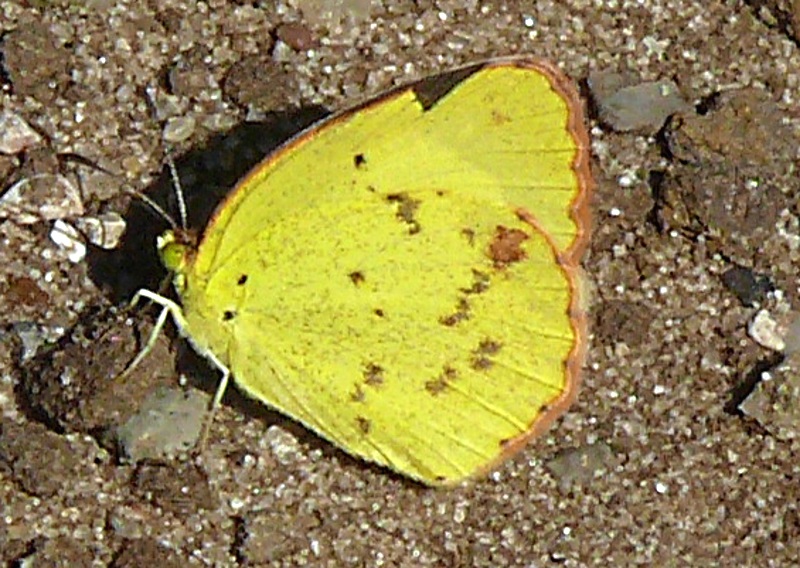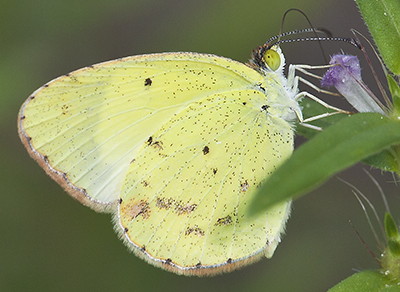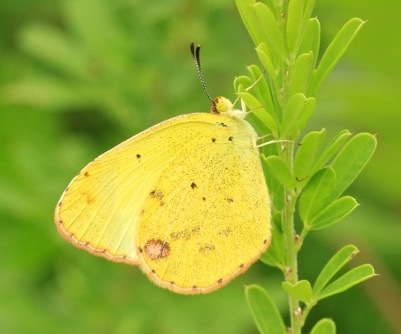|
| Common Name | Little Yellow by Paul Hart => Raven Rock State Park, 2004-09-29
[View PDF]
 Click to enlarge Click to enlarge
[Google Images] GBIF [Global Distribution ] BoA [Images ] iNaturalist |
| Scientific Name | Pyrisitia lisa
|
| Link to BAMONA species account. |
| Map | Click on a county for list of all database records for the species in that county.
 |
| Distribution | DISTRIBUTION: Statewide, and mostly a migrant into the state; primarily found in the Coastal Plain and lower Piedmont. Very rare at higher elevations.
|
| Abundance | ABUNDANCE: Quite variable from year to year. In "good years", fairly common to occasionally common in the southern Coastal Plain, from the coast to the Sandhills. Generally uncommon in the northern Coastal Plain and the eastern half of the Piedmont. Farther westward, uncommon along the southern tier of Piedmont and Mountain counties, but rare in most of the Mountains and northwestern half of the Piedmont. In "off years", such as during periods of drought or perhaps after a very cold winter, it is uncommon even in the southeastern Coastal Plain, and rare to absent in other parts of the state.
|
| Flight | FLIGHT PERIOD: Several broods in NC. The species appears to be mainly a migrant, with breeding status uncertain. Not at all common in the spring or early summer, occurring sparingly from mid-April into mid-June, at least in the Coastal Plain. However, from early July into early November the species can be numerous at times, particularly in Coastal Plain counties bordering SC. We have scattered records in late November and in December, as well as a few records from February and March.
|
| Habitat | HABITAT: As with all sulphurs and yellows, the species is found strictly in open country, though it is not found in cultivated fields and other farmland, and seldom in gardens. It is usually seen in open woodlands, wooded margins, or brushy places. It is often seen in a low, directional flight along the edge of a road or woodland margin, typically following the course of a dirt road or sand track to wherever it is going!
|
|
| | Plants | FOOD AND NECTAR PLANTS: Foodplants are mainly Common Partridge-pea (Chamaecrista fasciculata) and Sensitive Partridge-pea (C. nictitans). The species uses many nectar plants, mostly flowers close to the ground (within a foot of the ground).
|
| Comments | COMMENTS: As with many or most small butterflies, the species flies and nectars close to the ground, generally confining activities to within a foot of the ground. It especially is fond of hot, dry, sandy places, such as vacant lots and margins of dirt roads. Its status in spring and early summer is not well understood. There are alternating good years and bad years, often depending on rainfall in the Southeast -- a good flight during wet years (such as in FL, GA, and SC), and poor flights during droughts, though this is quite variable!
In 2012, there was an outstanding outbreak of the species in the state, with NC's highest one-day counts coming in this year, with a remarkable 185 tallied on a "Fourth of July" count in Rockingham County. What was shocking about 2012 was that the species first appeared in the Mountains, and was often common there by midsummer before it was being seen well downstate. This pattern clearly indicated a west to east movement, starting west of the Appalachians, likely through low Mountain passes. On the other hand, the flight in 2013 -- despite above normal rainfall in most of the Southeast -- was restricted mainly to the extreme southeastern coastal areas, ranging as far north as Croatan National Forest in Carteret County. In fact, our fourth highest one-day count was made in 2013, despite there being very few reports of Little Yellows away from coastal regions. In 2014, there was a late-season "push" of records into the state in fall; though numbers overall were small, there were a surprising 34 records for the Piedmont, with many fewer reports from the less well-worked Mountains and Coastal Plain. Another good flight occurred in 2016, with an excellent 99 reports from across the state, including 11 reports from the Mountains; our third highest one-day count also was made in 2016. The 2017 flight was only fair to mediocre, with a grand total of just 69 individuals among those reports. There was a modest (average) flight in 2018, with 52 records scattered across the state; but a quite sizable flight in 2019 (with 98 records). The 2020 flight was exceptional, with 2 of the top 3 state daily counts, including a one-person count of 300; however, the 2021 and 2022 flights were rather poor, with only 17 state reports in 2021 and 32 in 2022.
|
State Rank | S4 | | State Status | |
Global Rank | G5 | | Federal Status | |
| Synonym | Eurema lisa
|
| Other Name | Little Sulphur
|
|
|

 >>
>>

